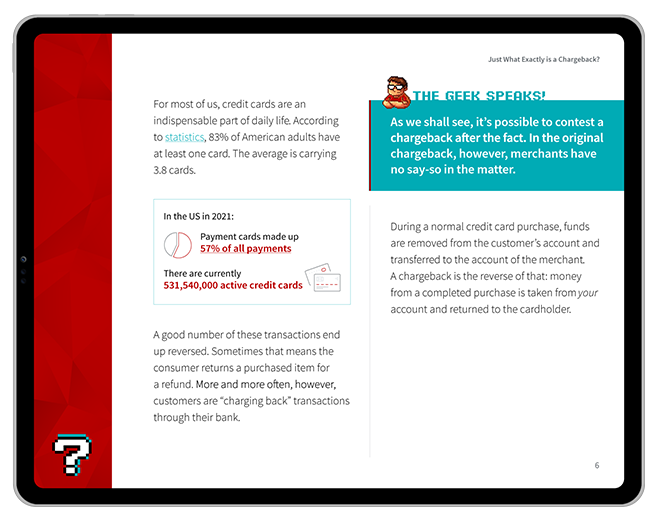Visa Dispute Monitoring Program: What is the VDMP, and How Does It Impact Merchants?
Beginning April 1, 2025, Visa will phase out its Visa Fraud Monitoring Program (VFMP) and Visa Dispute Monitoring Program (VDMP) for merchants operating in most global regions. The Visa Acquirer Monitoring Program will be enhanced to effectively replace these two programs.
If someone is performing a service in your name, it’s your reputation that’s on the line. Under those circumstances, you’d want to keep an eye on things, to make sure your image isn’t being tarnished. That’s the basic idea behind the Visa Dispute Monitoring Program; in effect, it is a means for Visa to protect the integrity of their network.
The VDMP gives Visa a way to help control chargeback activity at the merchant level. Visa can audit merchant outlets and identify businesses generating excessive disputes. Through the program, they can then take action to address the situation.
The program is meant to fulfill multiple functions for Visa: flagging potential bad actors engaged in merchant fraud, helping legitimate merchants manage chargebacks, defending cardholders, and protecting the Visa brand. With VDMP, acquirers can identify merchants who exceed Visa chargeback thresholds and help them find ways to reduce chargebacks. They may also use it to assess fraud controls and review operations.
But, what is the VDMP? What consequences does it carry for merchants, and how can you and how can you avoid it?
Recommended reading
- High-Risk Credit Card Processing: The Best Providers of 2024
- What is the Amex Fraud Full Recourse Program?
- High-Risk Merchant Accounts: The Best Providers of 2024
- How the Terminated Merchant File Can Affect Your Business
- Merchant Account Reserves: What You Need to Know in 2024
- What is a High-Risk Business? Why Does it Matter?
What is the Visa Dispute Monitoring Program?
- Visa Dispute Monitoring Program
The Visa Dispute Monitoring Program, or VDMP, is a compliance program administered by Visa for the purpose of controlling merchant chargeback issuances. If a merchant exceeds the monthly chargeback threshold set by Visa, they will be entered into the program. This will result in punitive fees, operating restrictions, and costly periodic reviews.
[noun]/vē • zə • dis • pyo͞ot • män • ə • dər • iNG • prō • gram/In simple terms, you can think of VDMP as a strategy put in place and administered by Visa to manage chargebacks on their network. The goal is ultimately to protect merchants and banks from damage caused by excessive chargebacks.
With VDMP, Visa is essentially saying that your business has received too many disputes lately. You may then be given a probation period in which to lower your chargeback ratio. Failure to do so will result in monthly fines, plus additional fees, operating restrictions, and costly periodic reviews.
If your business exceeds the monthly chargeback threshold, you could be entered into the program at Visa’s discretion. This assessment is based on your chargeback ratio, or the number of chargebacks filed against you compared to total transactions.
What Are the VDMP Program Thresholds?
There are three tiers of the VDMP. The program tier that applies to you is based on your chargeback ratio, but is also impacted by the overall number of disputes you received in a given timeframe. Your focus needs to be on keeping both numbers below the Visa chargeback monitoring program thresholds:
| Program | Monthly Threshold |
| VDMP Early Warning | 0.65% chargeback ratio and 75 chargebacks |
| VDMP Standard | 0.9% chargeback ratio and 100 chargebacks |
| VDMP Excessive | 1.8% chargeback ratio and 1,000 chargebacks |
Each program tier carries different requirements and limitations on your activity. Not surprisingly, the higher the tier, the greater the costs and restrictions:
VDMP Early Warning
At this stage, you’re not really in the program yet. This is simply a notification for you (as well as your acquirer) advising you to investigate the root cause of your rising chargeback levels.
VDMP Standard
Merchants are usually allowed a four-month workout period, during which you can try to bring your chargebacks under control. If you can’t make that happen, Visa begins your eight-month enforcement period.
VDMP Excessive Level
This is reserved for merchants who breach Visa’s excessive fraud threshold. Businesses with a high-risk merchant category code (MCC) may be placed here automatically.
VDMP Merchant Statuses: Notification, Workout, & Enforcement
Let’s say you’ve passed the Early Warning stage and advanced into the VDMP Standard tier. Now you’ll be dealing with one of three “statuses” that determine the fines and penalties you face:
Notification Status
This period refers to the first month after your account has been moved to the VDMP Standard tier. Visa will not impose per-chargeback fines during this period. That said, your processor is free to do so if they feel it is necessary or will compel compliance.
Workout Status
Following notification status, you will be given a timeline to resolve your dispute issue and bring your dispute ratio into compliance. As with notification status, Visa won’t issue fines at this stage. Again, though, you may be fined by your processor.
Enforcement Status
If your account is moved to the enforcement stage, Visa will begin issuing fines and penalties for each month your account meets or exceeds the VDMP Standard threshold. Also during this time, the network may require a detailed remediation plan.
How to Calculate Your Visa Chargeback Rate
Your chargeback ratio (or “chargeback rate”) is the figure that Visa uses to determine whether you’re compliant with card network chargeback limits. Thus, it’s important that you keep up-to-date information about your chargeback issuances.
Visa and Mastercard calculate your chargeback rate differently. For Visa, you simply divide the number of transactions submitted in the current month by the number of chargebacks issued during the same month.
Just a couple of other things to remember: First, Visa only considers the first ten chargebacks filed per card number, per merchant account. So, if one customer files a bundle of chargebacks all at once, only the first ten will count. Visa will also not count any chargebacks that fall under Visa Reason Code 10.5 (Visa Fraud Monitoring Program).
Consequences of Entering the VDMP
Being moved into the Visa Dispute Monitoring Program can cost you time, revenue, and other resources. You’re normally expected to work with your acquirer to develop a detailed chargeback-reduction strategy, called a chargeback mitigation plan. This plan — which must be presented to Visa — should identify the root cause of your chargeback problem, and also outline an appropriate strategy to correct it.
That doesn’t sound so bad; in fact, it’s likely to have a positive impact on its own. However, it can be difficult to accurately nail down what’s triggering your disputes. Also, the fees and added costs are where the program becomes problematic.
With the Visa VDMP program’s Standard tier, the network will begin fining your acquirer $50 for every dispute filed against you, beginning with the fourth month in the program (the enforcement period). That cost will be passed along to you, potentially with fines from other stakeholders.

For merchants whose chargeback problem is considered “excessive,” (i.e., significantly above the Visa chargeback threshold), the enforcement period is 12 months. There’s no grace period, either: the $50-per-dispute VDMP fine is in effect right from the start.
In both the Standard and Excessive VDMP, your acquirer will automatically deduct the fees from your account. There may be other associated costs as well. Processors, for example, may increase your regular processing fees until you exit the program.
There are also costly review fees to take into account. With both the regular and the excessive program, you’re subject to a $25,000 review fee toward the end of your enforcement period. Finally, if you’re unable to get your chargeback problem under control by the end of the enforcement period, your bank account may be closed, and you could be blacklisted from getting another merchant account.
How Can I Get Out of the VDMP?
Yes, you can. Despite how it may seem, the point of the Visa Dispute Monitoring Program is not to punish merchants. Rather, it’s to incentivize merchants to not only stop chargebacks from increasing but actually reduce chargeback volume.
You may exit the VDMP if you manage to bring your chargeback rate below the monthly threshold and keep it there for three consecutive months. If you can accomplish this for two months, but then breach the threshold again, you’ll have to start over. But, if you manage to successfully exit the program, you’re free to conduct business as usual, without the added program restrictions.
You may exit the VDMP if you manage to bring your chargeback rate below the monthly threshold and keep it there for three consecutive months.
That said, getting out of the VDMP can be pricey. Visa needs to make sure you’re really in compliance and can stay that way, so they may require a review. As mentioned above, a $25,000 review fee may be assessed toward the end of the enforcement period.
As a part of the VDMP, you’re expected to dedicate substantial effort and resources to get in compliance as quickly as possible. That’s why, if you’re not able to bring your chargeback rate within a compliant range during the 12-month program period, you may be disqualified from the Visa program entirely.
If you’re disqualified, you’d be barred from accepting Visa cards entirely. You would also likely lose your processing account, as your acquirer would regard you as too much of a liability. This could destroy your business.
How to Avoid Enrollment in VDMP
Keeping your operation compliant with the Visa Dispute Monitoring Program should be a priority. More broadly, this should also factor into your long-term strategy to reduce and prevent chargebacks of all kinds.
You can — and should — fight chargebacks through the representment process. However, this won’t have a direct impact on your chargeback rate, even if you win a reversal. The only way to ensure that you keep your chargeback ratio below the Visa threshold is to prioritize prevention. That calls for a comprehensive chargeback management plan aimed at identifying and remedying chargebacks by their source.
With that in mind, here are a few tips for preventing disputes and staying within the VDMP safe zone:
Need Help? We've Got You Covered.
Identifying dispute triggers, implementing prevention tactics, and carefully monitoring chargeback rates can all help keep you out of VDMP. Effective chargeback management, though, demands a lot of valuable resources. Most merchants struggle to stay on top of the situation, increasing the likelihood of additional losses.
Chargebacks911® can help deflect disputes, retain revenue, and keep your ratio safely below the Visa Dispute Monitoring Program threshold. Plus, all Chargebacks911 services are backed by a 100% ROI guarantee, meaning there’s no risk. Reach out to the experts today and see how much you stand to save.
FAQs
What is the chargeback program for Visa?
Visa’s chargeback monitoring framework is called the Visa Dispute Monitoring Program (VDMP).
What is the Visa Dispute Monitoring Program?
The Visa Dispute Monitoring Program, or VDMP, is a program administered by Visa for the purpose of controlling merchant chargeback issuances. If a merchant exceeds the monthly chargeback threshold set by Visa, they will be entered into the program. This will result in punitive fees, operating restrictions, and costly periodic reviews.
What is the early warning for the Visa dispute monitoring program?
VDMP Early Warning is simply a notification for you (as well as your acquirer) advising you to investigate your rising chargeback levels, as they are approaching thresholds.
What Happens if I Enter the VDMP?
Merchants in the Visa Dispute Monitoring Program face punitive operating restrictions, as well as a $50 per-chargeback fee. They will also be required to create a chargeback mitigation plan, and may face a $25,000 review process if they can’t reduce their chargeback issuances in the timeframe allowed by Visa.
What happens if I can’t get my chargeback rate under the Visa threshold?
If a merchant is unable to meet the requirements to exit the VDMP by the end of the program duration (4-12 months), they may be disqualified from the Visa program. This would leave them unable to accept Visa cards as payment.
How do I exit the VDMP?
To exit the VDMP, a merchant must bring their chargeback rate under the Visa threshold and keep it there for three consecutive months. In addition, Visa typically requires a $25,000 merchant review.
Is VDMP the Same as VFMP?
No. The Visa Fraud Monitoring Program, or VFMP, is similar to the VDMP. However, the programs have some key differences, including the standards required to maintain compliance, and the requirements for program merchants. You can learn more about the VFMP here.













